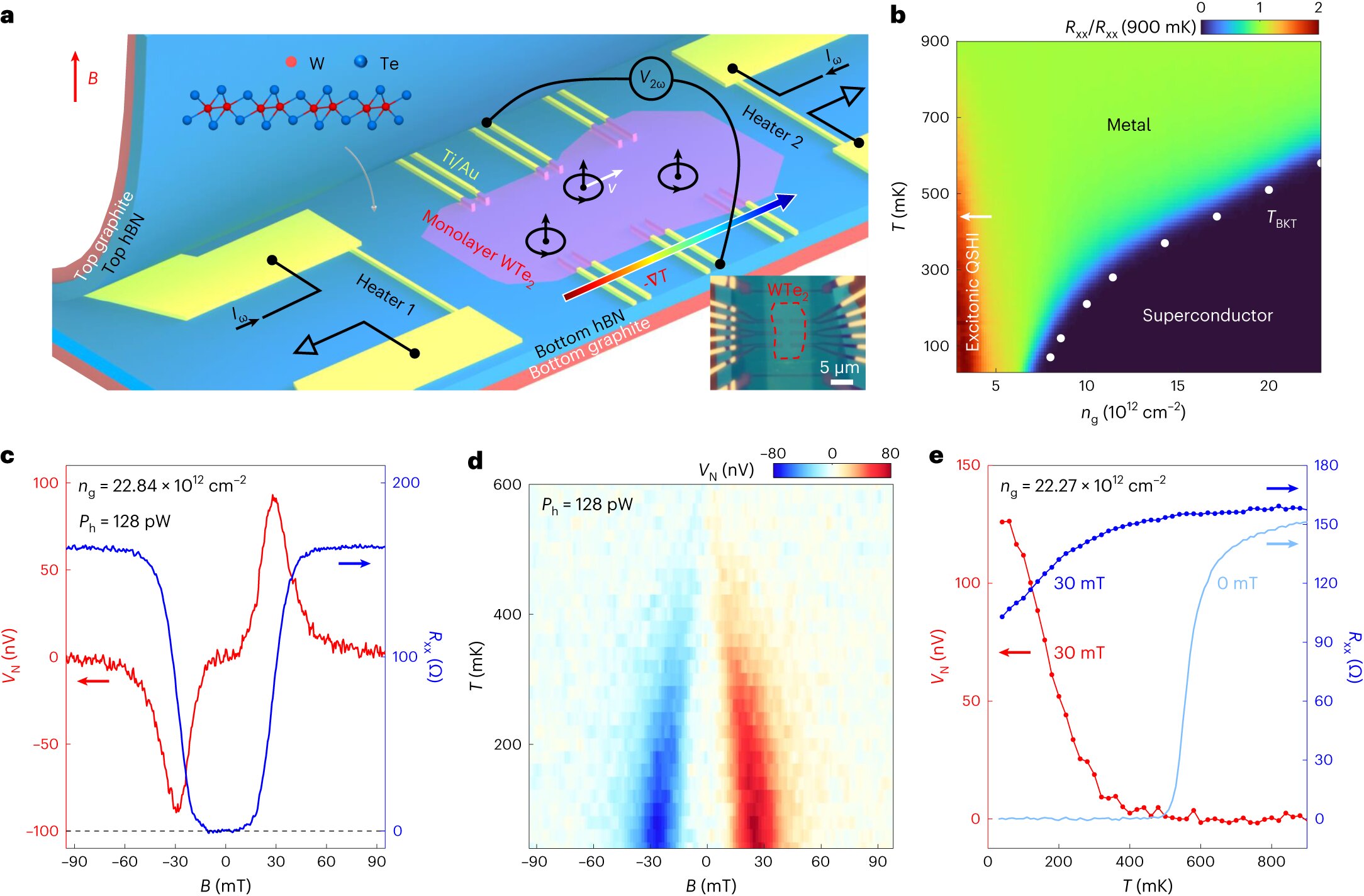Vortex Nernst effect and electronic phase diagram for WTe monolayer2. credit: Nature physics (2024). doi: 10.1038/s41567-023-02291-1
× Close
Vortex Nernst effect and electronic phase diagram for WTe monolayer2. credit: Nature physics (2024). doi: 10.1038/s41567-023-02291-1
Physicists from Princeton University discovered a surprising change in quantum behavior while experimenting with an insulator three atoms thick that can easily be turned into a superconductor.
The research promises to advance our understanding of quantum physics in solids in general, as well as push the study of quantum condensed matter physics and superconductivity in potentially new directions. the results It was published in the magazine Nature physics In a paper titled “Unconventional superconducting quantum criticality in monolayer WTe2“.
The researchers, led by Sanfeng Wu, an assistant professor of physics at Princeton University, found that the sudden stopping (or “death”) of quantum mechanical fluctuations exhibits a series of unique quantum behaviors and properties that appear to lie outside the scope of established theories. .
Fluctuations are temporary random changes in the thermodynamic state of a substance that is about to undergo a phase transition. A familiar example of a phase transition is the melting of ice into water. The Princeton experiment investigated fluctuations that occur in a superconductor at temperatures near absolute zero.
“What we found, by looking directly at quantum fluctuations near the transition, was clear evidence of a new quantum phase transition that violates the standard theoretical descriptions known in the field,” Wu said. “Once we understand this phenomenon, we believe there is real potential for a new and exciting theory to emerge.”
Quantum phases and superconductivity
In the physical world, phase transitions occur when a substance such as a liquid, gas, or solid changes from one state or form to another. But phase transitions happen at the quantum level as well. These changes occur at temperatures approaching absolute zero (-273.15°C), and involve constantly adjusting some external factor, such as pressure or magnetic field, without raising the temperature.
Researchers are particularly interested in how quantum phase transitions occur in superconductors, materials that conduct electricity without resistance. Superconductors can speed up the process of information and form the basis of powerful magnets used in healthcare and transportation.
“How one superconducting phase can be changed into another is an interesting area of study,” Wu said. “We have been interested in this problem in thin, clean, single crystalline materials for a while.”
Superconductivity occurs when electrons pair up and flow in unison without resistance and without dissipating energy. Normally, electrons travel through circuits and wires in an irregular manner, colliding with each other in an ultimately inefficient manner that wastes energy. But in superconductivity, the electrons work in concert in an energy-efficient way.
Superconductivity has been known since 1911, although how and why it worked remained largely a mystery until 1956, when quantum mechanics began to shed light on the phenomenon. But superconductivity has only been studied in the past decade or so in clean, atomically thin, two-dimensional materials. In fact, superconductivity was long thought to be impossible in a 2D world.
N said “This happened because when you go to lower dimensions, the fluctuations become so strong that they kill any possibility of superconductivity,” said Fuan Ong, a professor of physics at Princeton University and author of the paper.
The main way in which fluctuations destroy 2D superconductivity is the spontaneous appearance of so-called quantum vortices (plural: vortices).
Each vortex resembles a small vortex consisting of a microscopic strip of magnetic field trapped within a moving electron stream. When the sample is raised above a certain temperature, vortices spontaneously appear in pairs: vortices and antivortices. Their rapid movement destroys the superconducting state.
“The vortex is like a whirlpool,” Ong said. “They are quantum versions of the vortex that appears when you drain a bathtub.”
Physicists now know that superconductivity in ultrathin films actually exists below a certain critical temperature known as the BKT transition, named after condensed matter physicists Vadim Berezinsky, John Kosterlitz, and David Thewlis. The latter two shared the 2016 Nobel Prize in Physics with physicist F. Duncan Haldane, professor of physics at Sherman Fairchild University.
BKT theory is widely viewed as a successful description of how quantum vortices in 2D superconductors can multiply and destroy superconductivity. The theory applies when superconductivity transition is induced by heating the sample.
Current experience
The question of how to destroy 2D superconductivity without raising the temperature is an area of active research in the fields of superconductivity and phase transitions. At temperatures near absolute zero, quantum switching occurs via quantum fluctuations. In this scenario, the transition is different from the temperature-induced BKT transition.
The researchers started with a huge crystal of tungsten ditelluride (WTe2), which is classified as a layered semi-metal. The researchers began by converting tungsten ditelluride into a 2D material by incrementally peeling the material down to a single atom-thin layer.
At this level of thinness, the material behaves like a very strong insulator, meaning that its electrons have limited mobility and therefore cannot conduct electricity. Surprisingly, the researchers found that the material exhibits a range of new quantum behaviors, such as switching between insulating and superconducting phases. They were able to control this switching behavior by building a device that worked just like an “on/off” switch.
But this was only the first step. Next, the researchers subjected the material to two important conditions. The first thing they did was cool the tungsten ditelluride to exceptionally low temperatures, about 50 millikelvin (mK).
Fifty millikelvin is -273.10 degrees Celsius (or -459.58 degrees Fahrenheit), an incredibly low temperature where quantum mechanical effects dominate.
The researchers then converted the material from an insulator to a superconductor by introducing some extra electrons into the material. It didn't take much effort to reach the superconducting state. “Only a small amount of gate voltage can change the material from an insulator to a superconductor,” said Tianqing Song, a postdoctoral researcher in physics and lead author of the study. “This is a really cool effect.”
The researchers found that they could precisely control the properties of superconductivity by adjusting the electron density in the material via the gate voltage. At a critical electron density, quantum vortices rapidly multiply and destroy superconductivity, triggering a quantum phase transition.
To detect the presence of these quantum vortices, the researchers created a small temperature gradient in the sample, making one side of the tungsten ditelluride slightly warmer than the other. “The eddies are looking for the cooler edge,” Ong said. “In a thermal gradient, all the vortices in the sample drift into the cooler part, so what you've created is a river of vortices that flows from the warmer part to the cooler part.”
The vortex flow generates a detectable voltage signal in the superconductor. This is due to an effect named after Nobel Prize-winning physicist Brian Josephson, whose theory predicts that when a stream of eddies crosses a line drawn between two electrical conductors, it generates a weak transverse voltage, which can be detected by nanovolts. meter.
“We can verify that this is the Josephson effect; if you reverse the magnetic field, the detected voltage reverses,” Ong said.
“This is a very specific signature of an eddy current,” Wu added. “Directly detecting these moving vortices gives us an experimental tool to measure quantum fluctuations in a sample, which is difficult to achieve otherwise.”
Amazing quantum phenomena
Once researchers were able to measure these quantum fluctuations, they discovered a series of unexpected phenomena. The first surprise was the amazing power of the vortexes. The experiment showed that these vortices persist at temperatures and magnetic fields much higher than expected. They survive at temperatures and ranges much higher than the superconducting phase, the resistive phase of matter.
The second major surprise is that the vortex signal suddenly disappeared when the electron density was set below the critical value at which the quantum phase transition of the superconducting state occurs. At this critical value of electron density, which researchers call the quantum critical point (QCP) which represents a point at zero temperature in the phase diagram, quantum fluctuations drive the phase transition.
“We expected to see persistent strong fluctuations below the critical electron density on the non-superconducting side, just like the strong fluctuations seen well above the BKT transition temperature,” Wu said.
“However, what we found is that the vortex signals 'suddenly' disappear the moment the critical electron density is exceeded. This was a shock. We cannot explain this observation at all – the 'sudden death' of fluctuations.”
“In other words, we have discovered a new type of quantum critical point, but we don't understand it,” Ong added.
In the field of condensed matter physics, there are currently two well-established theories explaining superconductor phase transitions, the Ginzburg-Landau theory and the BKT theory. However, the researchers found that none of these theories explain the observed phenomena.
“We need a new theory to describe what happens in this case, and this is something we hope to address in future work, both theoretically and experimentally,” Wu said.
more information:
Tianxing Song et al., Importance of non-classical superconducting quantum in monolayer WTe2, Nature physics (2024). doi: 10.1038/s41567-023-02291-1

“Extreme travel lover. Bacon fanatic. Troublemaker. Introvert. Passionate music fanatic.”






More Stories
The real-life 'Baby Reindeer' stalker is speaking out after the Netflix show aired
Scientists discover a “surprise” that changes their understanding of the universe
Real 'Baby Reindeer' Woman Claims 'Richard Judd Is Following Me'